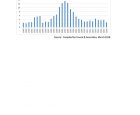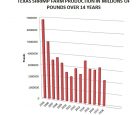
Features
Profiles
Declining trends in hatchery shrimp supply forcing US producers to go it alone
The decline in post-larval (PL) shrimp survival rate and closure last year of the biggest shrimp hatchery in the U.S. have led some growers to put up their own hatcheries for self-sufficiency.
May 6, 2019 By Ruby Gonzelez
“Producers have been forced to build their own hatcheries to survive. This is a very expensive process,” Granvil Treece, founder at Treece & Associates, told Hatchery International. He cited two of the largest producers in the U.S.
Bowers Shrimp Farm, the largest producer of farm-raised shrimp in America, is building its own hatchery in the Port of Palacios in Texas and plans to haul water from offshore. Owner Reed Bower told Hatchery International they have started putting up the hatchery and received their broodstock in mid-January. Their nursery was built in 2013.
As part of its 2019 program, Trans American Aquaculture in Texas is building its own hatchery and broodstock facility on site.
“The PL situation in the U.S. came to boil and exploded in 2018,” he said.
The major triggers he cited were the decline in the quality of PLs of what used to be the largest supplier of PLs, and a hatchery damaged by a Hurricane Harvey in 2017.
The trend was likewise observed in the other farmed shrimp-producing states, Alabama and Florida.
U.S. production of almost 4 million lbs. in 2017 was down to less than 2.5 million in 2018. Shrimp production in the U.S. peaked in 2003 with over 13 million lbs. (See Table 1)
In the past 14 years, production of farm-raised shrimp in Texas, the country’s biggest producer, was also at its lowest in 2018 at 2.17 million lbs. This is less than a third of 2005’s 6.8 million lbs. (See Table 2).
Some hatcheries have expanded to meet the U.S. demand. “Robin Pearl’s American Mariculture in Florida expanded and supplied some farms,” Treece said.
Print this page
Advertisement
- Opinion: Beyond the farm
- Imported shrimp causing concern over antibiotic-resistant bacteria, NaturalShrimp says







